Posts Tagged ‘Loch style wet flies’
{{start}}
Loch Style fly-fishing involves fly-fishing from a boat, side onto the wind, using a system incorporating one or a number of flies. There are both wet and dry lock style fishing techniques. There are four distinct sub sections of loch flies: wake or bob flies, dropper flies that can be placed in various position s in a team of flies for different effects, attractor flies which are generally fished on a middle dropper and point flies.
The dry fly technique involves casting out in the direction of the drift, stopping the cast above the water so as to let the team of flies settle, waiting the desired time (often only 5 to 10 seconds) and then repeating the process in a slightly different position. Dry fly Loch style fly fishing covers a lot of water in a short time. The flies used are ordinary dry flies such as those shown in the dry fly page of this website. When selecting a team of flies try to balance the selection so that the most aerodynamic fly is on the point and the least aerodynamic fly is on the top dropper.
The wet technique involves casting out in the direction of the drift, fishing the flies using a range of techniques. Wet fly loch fly fishing, as well as incorporating a range of different retrieves and fly lines ranging from floating right through to very fast sinking lines can also involve fishing: the drop, the retrieve, the stop, the lift, the hang and the dibble and the dapple.
{{end}}

{{+1}}PTN variant{{-1}}
{{start}}
This variation of Frank Sawyers pheasant Tail Nymph takes into account the shorter herl on pheasant tails that dominate the market these days and to include the substitution of peacock or coloured dubbing in the thorax and the addition of legs.{{end}}
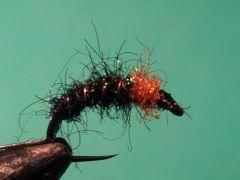
{{+1}}Tiger midge{{-1}}
{{start}}
This is a great dropper fly in lakes where there are populations of midge and my good mate Peter Walsh, who first came up with particular tie, fishes it with plenty of confidence and results. It's a lot like my Bibio variant except that the dominant colours are black and orange as apposed to back and red and it is tied without a front hackle.{{end}}

{{+1}}Sparkler{{-1}}
{{start}}
When a seriously flashy fly is needed because of visibility or you just need a fly to excite fish this fly may save the day.{{end}}

{{+1}}BH silver surfer{{-1}}
{{start}}
I was ripping the black tailed version of this fly through the chop with some success when my boat partner asked what fly is that 'silver surfer'. I explained to him that it was just a woolly bugger variant tied with a black tail and silver UV straggle fritz. I tried to give it a real name such as 'silver woolly bugger' but unfortunately 'silver surfer' has stuck.{{end}}
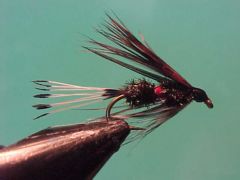
{{+1}}Royal coachman wet – Chatto’s version{{-1}}
{{start}}
One of the first wet flies tied was the coachman and that consisted of just a black body and a a set of white hackle slip wings. Over time flies have evolved and one path the coachman took was the substitution of a "royal" body for the simple black body. Many versions have been tied since and this one works for me.{{end}}

{{+1}}Mallard and claret – Chatto’s soft hackle version{{-1}}
{{start}}
One of the first loch flies I was introduced was a mallard and claret tied in a traditional way with a pair of feather slip wings. I thought it was the bees knees as a bob fly and used it any time when mayflies were around. For me this is a vastly superior fly and as well as being a great substitute for a traditionally tied mallard and claret also works well on mayfly feeders taking pre emergers.{{end}}

{{+1}}Fuzzel Katie – Kate McLaren variant{{-1}}
{{start}}
I particularly find the yellow version useful when yellow winged hoppers or other insects with yellow parts are on the trouts menu. At other times pink is a great trigger color and when combined with the flash of the holographic tinsel and or the movement of the fuzzeled body and the soft front hackle are often enough to trigger a response.{{end}}
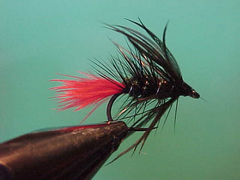
{{+1}}Zulu – Chatto’s variants{{-1}}
{{start}}
I have changed the materials from the originals to include a couple of my fly tying favorites namely marabou for the tail, peacock herl for the body and a crow breast feather up front. If you swap the front feather to a blue feather such as swamp hen or a smallish peacock breast feather you have the also popular blue Zulu.{{end}}
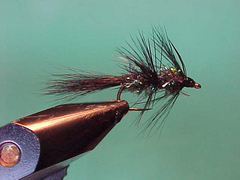
{{+1}}Fuzzy Wuzzy{{-1}}
{{start}}
Originating in New Zealand in the 1930's this fly was first dressed in colours of black and red and was designed as an evening or night fly representing a local crayfish. The fact that it is highly visible and symmetrical has allowed the Fuzzy Wuzzy to evolve into a must have fly with applications across a wide range of situations.{{end}}
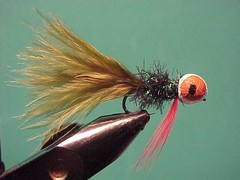
{{+1}}Lakes – loch style … all pumped up / booby pumping{{-1}}
{{start}}
There is nothing new about "Booby Pumping". English fly fishers have been doing it for years and for a time it was considered so successful in some impoundments that it was banned. I have been fishing boobies for quite a few years and booby pumping has even won a couple of competitions for me.{{end}}













